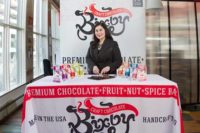Capturing the Young
and the Restless
By Renée M. Covino
Candy marketers will have to rely on new energy to
successfully target the on-the-go, information-savvy,
shopping-empowered tweens and teens of today.
There is
currently no official name for our country’s youngest generation
because it has not yet reached adulthood—the time when marketers
begin to classify same-aged segments by their common psychographic traits
and generational generalities. But while this group may not yet have a
catchy name, they certainly have spending power that marketers want to
catch—today’s tweens and teens are consumer-conscious in ways
previous generations never were at their age, and they have the bucks to
back it up.
According to Teenage Research Unlimited, tweens and
teens aged 12 to 19 spend an average of $91 per week. Sliced a different
way, eight- to 11-year-olds receive an average of $780 annually from gifts
and allowances, with their spending power totaling $13 billion, according
to a Packaged Facts report titled “The U.S. Tweens Market.”
Looking to the future, Packaged Facts reports that customers aged eight to
14 will have an expected buying power of $43.5 billion by 2007.
While the candy industry has always naturally targeted
the younger segment of the population, this up-and-coming generation is
being defined as a new breed requiring new marketing energy. What attracted
the Baby Boomers, Gen Xers, and even the Millenials before them,
doesn’t apply to today’s youth. It is vital that the
confectionery industry keep on top of these newly emerging tween and teen
markets in order to know how best to target them.
“Zap the gap.” This
is a phrase coined by marketing consultancy Yankelovich Inc. to indicate
that the generation gap that many of today’s parents experienced in
their youth has diminished significantly—and marketers should respond
accordingly. In its summer-released 2005 Youth Monitor study sponsored
by Disney, phrases like “pester power” and the “nag
factor” that are used by marketers to describe the way children talk
their parents into making purchases, were shown to be archaic and
irrelevant, missing several key emerging trends among kids and their
parents today.
“Getting kids to nag their parents is not the
most effective focus of marketing dollars anymore,” says John Page,
Youth Insights manager at Chapel Hill, N.C.-based Yankelovich. “In
fact, marketers should avoid pitting kids against parents at all costs
because it flies in the face of the kind of interaction parents and
children want with each other.”
Instead, the youth study, now in its tenth wave,
recommends that marketers adopt a spirit of “team
decision-making” as the way to connect with kids and their families.
This means that marketing messages should take into account that not only
do kids and parents respect each other’s opinions, but often they
genuinely enjoy a lot of the same experiences and products. Recent examples
in the marketplace include the latest electronic gadgets such as camera
phones and iPods, recent blockbuster hits such as The Incredibles and Shrek 2, and the continuing popularity
of “evergreen” consumable brands, including candy.
Focus on parents, too. Hand-in-hand
with the findings from the Yankelovich study, comes the new thinking that
parents should be included in teen and tween market research—easily
accomplished in venues like focus groups.
“The information that comes from involving the
parents in the research is invaluable,” says Billie Blair, an
organizational psychologist, and president and CEO of management consulting
firm, Leading and Learning, Inc., based in Los Angeles. “Marketers
need to structure it so that parents don’t take over the focus, but
their viewpoint is important,” she says.
The Yankelovich study did, in fact, include parents and
found that half of them “really enjoy a lot of today’s pop
culture, such as music, fashion, the popular shows and celebrities, and
things like that.”
According to Page, “This is an impressive number
given adults’ propensity of believing the ruling pop culture of their
youth couldn’t possibly be matched. But we have to remember that
today’s parents are, to a significant degree, the MTV, original Star Wars, and “Star
Search” generation. So in some respects, the ruling pop culture of
their youth is frequently echoed in today’s pop culture.”
And as far as shopping is concerned, while teens and
tweens might like different places to shop than their parents do, they
don’t mind including them in the process. In a recent qualitative
study with tween and teen girls aged 12-19 that shopped a Fort Worth,
Texas, mall, Julie Baker, an associate professor of marketing at Texas
Christian University, found that even though many of the girls in the study
did their initial browsing with friends, they often brought their moms back
to buy.
Intermix entertainment. Remember
when marketers had to proceed cautiously when they crossed the line between
marketing and entertainment? Well, now they can throw caution to the wind.
“Tweens and teens are looking for passion for
the brands they care about,” says Page. “They’re really
open to entertainment and marketing intermixing. The idea of ‘selling
out’ is not as much of a concern for kids.”
Some in the industry call this
“advertainment.” When the Internet is involved, it can be
referred to as “Intertainment.”
While the Internet wasn’t considered a branding
medium even as recently as a few years ago, it certainly is now, according
to Daniel Stein, managing director for EVB, an online advertising and
website development agency, based in San Francisco. Currently, EVB is the
online agency for the Wm. Wrigley Jr. Company—it does all of its
online advertising and website development for all brands.
“A lot of our clients are finding that TV and
traditional media work really well to get the attention of teens and
tweens, but they’re turning to the Internet for long-term loyalty and
to engage the customer with the brand for a longer amount of time,”
says Stein.
Games and music are hot advertising components to the
teen/tween sector and candy marketers are encouraged to utilize them as
much as possible. “We’re seeing brands getting involved
in concert tours, proprietary music bites that teens can’t get
anywhere else, clips of events they enjoy such as Nascar, unique video
games, etc.,” Stein maintains. “Just letting teen fans know
that ‘this great entertainment was brought to you by this
brand’ will work. And if you can integrate your brand into games or
music available on your website, it’s that much better.”
Fit in health. The
jury is still out on whether or not teen and tween behavior matches their
aspirations on healthier snacking, but marketers should at least be aware
that teens/tweens are more than aware of the healthy hype.
According to a recently-released food and beverage
study by New York-based BuzzBack Market Research,“Teens and Healthy
Eating: Oxymoron or Trend?,” teens are receptive to change and love
trying new products. Of the teens surveyed, more than two-thirds tried a
new snack, food or beverage within the last year, and among younger teens,
the percentage was even higher (75 percent). The study also found
that teens tend to find food with added benefits (e.g., extra vitamins)
more appealing than foods with reduced levels of ingredients (e.g., reduced
salt, sugar, or carbs).
“The health theme of our study is that yes,
teens seem to want healthier foods and to eat healthier, but at the end of
the day, they also still want their favorite snack foods, including
candy,” says Carol Fitzgerald, president and co-founder of BuzzBack.
“However, there’s definitely an awareness of health starting
younger.”
Keeping up with that trend, Cargill, one of the
world’s largest ingredients suppliers, has integrated consumer
insight with its expertise in ingredient formulation and food systems
technology to develop nutritious products that appeal to tweens aged eight
to 12. Resulting innovations were showcased in “a school cafeteria of
the future” within the company’s booth at the 2005 Institute of
Food Technologists (IFT) Food Expo in July.
According to Pam Stauffer, marketing manager for
Cargill, the company is featuring confectionery prototypes such as gummy
bears with a sugar substitute and sugar-free chocolate with inulin, which
some studies have shown to increase calcium absorption. “Different
companies are looking for different ways to innovate that will appeal to
tweens right now. Chews are a very popular delivery method in
confections,” she says. “Bars are also hot, as is
reduced-calorie chocolate with a great taste and good mouth
feel.”
Keep it ethical. Many
candy marketers have certainly been on top of better-for-you candy, but
what about “better-for-them” marketing? Clearly, companies
can’t be responsible marketers to kids these days without considering
the ethical issues.
“The problem today is that the fast pace of
society and technology has dramatically changed the way our kids get
messages through the media,” states Robert Reiher, Ph.D., co-author
of “Kidnapped: How Irresponsible Marketers Are Stealing the Minds of
Your Children.” He cautions marketers that “about 73 percent of
parents are now in favor of restricting marketing or advertising to
kids,” and that “if there’s no self-regulation from the
industry, bills are in place and getting ready to pass.”
How Well Do You Know Them Now?
Today’s teens and tweens are savvy consumers who
interact well with their parents. Candy marketers may want to consider some
enlightening takeaways from the Yankelovich Youth Monitor 2005, sponsored
by Disney, and Monitor II 2005, when re-acquainting with this vital youth
market.
91 percent of kids
say spending time volunteering or helping other people is very or somewhat
important to them, up from 79 percent in 1997.
70 percent of
12-17s agree that, “very little, if any, of the advertising I see has
to do with the things I care about or am interested in.”
46 percent of
12-17s say when a company makes a donation to their school or community
they feel their family should try to buy things from that company as
often as possible.
94 percent of
12-17s believe people should be free to look, dress, and live the way they
want to whether others like it or not.
About half (51
percent) of 12-17s agree that, “I usually buy the same brands my
friends do.” This was down from 63 percent in 2001.
Less than half (46
percent) of 12-17s agree that, “I like to buy brands that make me
feel like I’m in the ‘in’ crowd,” down from 54
percent in 2001.
Candy Dreams of Some Teens and Tweens
Listen up, candy marketers! According to the
Yankelovich Youth Monitor 2005, sponsored by Disney, 81 percent of kids say
more companies need to ask them what they think about products, and that
manufacturers are not grasping their preferences and interests.
So here are some specific confection ideas right out of
the mouths of teens and tweens, as compiled recently by BuzzBack Market
Research firm in New York City as part of its 2005 report, “Teens and
Healthy Eating: Oxymoron or Trend?”
“I would
invent a chocolate candy bar that had zero calories in it, but was all
natural with no chemicals and tasted like the real thing.”
“I would
create a new food that tasted very good like a candy bar, but was very
healthy for you and didn't add any weight to you.”
“I would
invent an everlasting gum. I am not sure what the ingredients would be, but
the flavor would never run out.”
“A make-your-own candy bar product. You would get different
ingredients in the package and there could be different kinds of candy bar
packages to choose from.”
“Ice-cream-filled
M&M's. They would be bigger than normal M&M's so you can taste the
ice cream in the middle.”
“Chocolate
candy that is reduced-fat such as fat-free Snickers bars and reduced- fat
cinnamon buns.”
“A
cotton-candy-flavored candy bar.”
To the Tune of Tweens and Teens
Music, radio, and movies go really well with
candy—especially when promoting to the tween/teen crowd, as evidenced
by some of the most recent summer programs.
Just in time for the Charlie
& the Chocolate Factory movie release,
Nestlé’s Wonka brought the magic of the movie to life with a
real nationwide search to find five golden tickets. Inside specially marked
packages of Wonka candy, are five grand prizes—one-of-a-kind
experiences themed around characters from the film and tied to specific
Wonka candies—worth $10,000 each.
Malibu Toys is using “pop-sensibility” to
delve further into the tween market as it recently announced its exclusive
sponsorship deal for its Finger Lights Light-Up Candy Rings with new tween
pop group sensation, The Gemz. Finger Lights will be distributed at all
Gemz tour appearances, and the five-member girl group will wear the candy
rings during promotional appearances.
Hershey’s Ice Breakers Liquid Ice breath mints
partnered up with Hilary Duff’s summer concert tour, setting up at
concert venues to sample products as well as running games and trivia
contests in exchange for upgraded tickets and other branded Ice Breakers
Liquid Ice premium items.
Trident’s new Fusion flavors teamed up with Teen People magazine for an
exclusive “Listening Lounge” event in New York City featuring
the Backstreet Boys before they embarked on their summer tour. Fans were
encouraged to participate in an exclusive “fashion fusion”
contest where they hit the runway and showed off their own fashion fusion
creations.
Cadbury Adams is also on the tween/teen scene with its
Swedish Fish, Sour Patch and Chiclets brands as they hosted “Sweeten
Your Tone” events and sweepstakes in major cities across the country.
Recording artists Ryan Cabrera and Vanessa Carlton appeared at some events
where limited edition ringtones of their music were made available to
consumers who stopped by with the appropriate candy proof-of-purchase
labels.
Just Born’s Mike and Ike candies sponsored a
summer radio program complete with fun promotions, cool giveaways, lots of
free candy and teen-relevant advertising.
Appealing to older teens, Just Born’s Hot
Tamales hosted a candy sampling event at college campuses nationwide this
past spring. The brand also sponsored a National Hot Tamales Hotties Tour,
in which students competed for the hottest look on their campus and
nationally.





